Locus’ cloud-based environmental data management and EHS compliance software solutions are built on the cloud— read more about how we use the cloud to help our customers.
Finally, An Environmental Software Suite that Works Together
When looking for a GHG reporting program, there is one element that is typically overlooked. This short video gives us more insight.
Foster Farms Selects Locus Technologies EHS/ESG Enterprise SaaS
MOUNTAIN VIEW, Calif., May 2, 2023 — Locus Technologies, the leading EHS Compliance and ESG software provider, today announced that Foster Farms, a top US provider of fresh, frozen, and prepared poultry products and the leading brand of fresh chicken in the Western U.S., selected Locus’s award-winning enterprise Software as a Service (SaaS) to organize and manage their EHS compliance and ESG reporting.
Foster Farm subscribed to an integrated set of apps offered in the Locus Cloud Platform. Some apps include EHS Compliance Management, ESG and Sustainability, GHG Emission Factor and Calculation Management, Inspections, Configuration Workbench, Air Emissions Management, Storm Water, Wastewater, and well data management and reporting.
Locus Cloud is the first fully integrated multitenant platform created from the ground up to allow organizations to manage their environmental, energy, water, waste, carbon, air, health and safety, remediation, water quality, and compliance information in one place. The Locus Platform allows companies to configure their own management, tracking, visualization, and reporting through a graphically driven user interface. This feature enables organizations to configure the software to their needs without worrying about the expensive programming outlays usually associated with customization and single-tenant deployments.
When designing integrated EHS/ESG SaaS, Locus sought to make the complicated workflow and management of environmental data as simple as possible and to make it manageable from a single platform with shared components. The resulting platform offers immense flexibility and endless capabilities with minimal training thanks to the new, intuitive, user-friendly interface design.
“The accurate tracking and reporting of critical environmental resource usage is a necessary part of our compliance responsibilities, and a major component of our efforts to ensure that we are a sustainable producer. The Locus application software will make a significant contribution to our resource management capabilities,” said Don Hill, Foster Farms Director of Environmental Affairs.
“We are delighted that Foster Farms recognized the power of the Locus Cloud platform. Businesses do not want to shop for point solutions from different vendors only to be left with the nightmare of integration, security, synchronization, and vendor management. They want one-stop shops and to avoid having to deal with vendors that don’t integrate well with one another or have spotty service and limited support. Locus will provide Foster Farms single platform through which they can accomplish all their environmental and compliance management needs on a single, fully customer-configurable platform,” said Neno Duplan, President, and CEO of Locus. “Keeping the end user’s perspective in mind, we’ve packed the same 26-plus years of domain expertise that Locus has been offering all along into a highly configurable and scalable software platform built from the ground up on the latest web technologies,” remarked Duplan.
ABOUT FOSTER FARMS
Foster Farms is dedicated to providing families across America with great food. From ready to cook chicken and turkey, to chicken nuggets and corndogs, Foster Farms portfolio of fresh, frozen, and prepared foods, are always welcome whether it’s dinner time or snack time. Since its founding in 1939 Foster Farms has gone on to become one of the largest quality poultry producers in the United States. Headquartered in Livingston, Ca with facilities in California, Oregon, Washington, Colorado, Arkansas, Alabama and Louisiana, the company has nearly 12,000 Team Members, and is committed to building a “culture that nobody wants to walk aways from.”
Locus Technologies Receives 17th Consecutive EBJ Award for Information Technology in ESG
MOUNTAIN VIEW, Calif., 2 March 2023 — Locus Technologies, the leading EHS Compliance and ESG software provider, received their 17th consecutive award from Environmental Business Journal (EBJ) for growth and innovation in the field of Information Technology in the environmental software with particular focus on EHS, compliance, sustainability, and ESG.
Locus continues to expand its ESG SaaS solution, including built-in business intelligence tools for interactive, actionable insights into unified EHS compliance and ESG data, forecasting tools predicting future ESG reporting, APIs for utility data sources, and interfaces with third-party systems that house ESG data. Locus’s ESG solutions focus on “enter once, report to many.” enabling companies the efficiency of reporting to multiple organizations and numerous standards from a single dataset. Essential built-in reporting includes state or federal regulations and ESG based on standards, including CDP, GRI, SASB, TCFD, and many others.
“Locus’s pioneering work in integrated ESG reporting and EHS compliance software is paying off. As one of the early SaaS leaders in net-zero digital solutions for ESG reporting, Locus continues to provide value to companies that want to be credible with their carbon reporting and sustainability software.” said Grant Ferrier, president of Environmental Business International Inc. (EBI), publisher of Environmental Business Journal.
“With energy transition, climate resilience, and new federal programs driving business, as well as traditional environmental market drivers in infrastructure, air quality, remediation, water and wastewater it is understandable that companies that offer integrates SaaS platform like Locus has advantage.” added Ferrier.
“As Locus continues to expand our EHS and ESG software we would like to thank EBJ for recognizing Locus again for a 17th consecutive year and for noting the new functionality and growing customer base we achieved in 2022. Locus will continue this trajectory into 2023 with new tools designed to simplify EHS and ESG management in our award-winning Locus software, which offers a single system of record and truth for our customers. Locus SaaS platform enables our customers to manage their carbon transactions and inventory with the same rigor, confidence, and transparency as their financial ones.” said Neno Duplan, the Founder and CEO of Locus Technologies.
San Jose Water Expands Locus Technologies SaaS to include GIS+
MOUNTAIN VIEW, Calif., 14 February 2023 — Locus Technologies, the leading EHS Compliance, and ESG software provider, today announced that San Jose Water (SJW), an investor-owned public utility providing water service to a population of approximately one million people in the Santa Clara Valley, has expanded Locus’ environmental information management software to use Locus GIS+ for advanced GIS analysis.
SJW has been using Locus SaaS and mobile app since 2014 to manage its field data collection, water quality compliance, and regulatory reporting. SJW also uses Locus to track sewer discharges and well blow-offs.
“Our responsibility is to ensure our customers receive the highest quality drinking water from their taps. We monitor the quality and cleanliness of our water in terms of state and federal regulatory requirements. In 2021, our highly experienced staff collected more than 1,000 regulatory and non-regulatory samples from our distribution system and treatment plant, generating over 23,000 data points. To manage this data effectively, we used Locus’ cloud-based software. GIS mapping capabilities are essential for our environmental data analysis. Locus GIS+ will allow quick data visualization and is a quantum leap forward with advanced analysis tools that use Esri’s Smart Mapping technology,” said Suzanne DeLorenzo, the Director of Water Quality at San Jose Water.
“Locus’s mission is to help organizations, such as San Jose Water, to achieve their business goals by providing them the software tools to manage key data associated with water quality and compliance reporting,” said Neno Duplan, CEO of Locus. “With GIS+, SJW will have all the tools they need to perform a wide range of geospatial data analysis across their distribution system. Our water quality management cloud-based software, coupled with GIS+ and Locus Mobile for field data collection, provides our customers with a highly scalable and feature-rich application that gives water utilities strong analytical power and advanced GIS capabilities.”
Locus GIS+ is powered by Esri’s ArcGIS platform and offers various advanced features— including enhanced cartography, comprehensive spatial data analysis, and the ability to use the customer’s map data through integration with ArcGIS Online and Portal for ArcGIS.
ABOUT SAN JOSE WATER
Founded in 1866, San Jose Water is an investor-owned public utility and is one of the largest and most technically sophisticated urban water systems in the United States. Serving over one million people in the greater San Jose metropolitan area, San Jose Water also provides services to other utilities, including operations and maintenance, billing, and backflow testing. San Jose Water is owned by SJW Group, a publicly-traded company listed on the New York Stock Exchange under the symbol SJW. SJW Group also owns Connecticut Water Company in Connecticut; Maine Water Company in Maine; and SJWTX, Inc. (dba Canyon Lake Water Service Company) in Texas. To learn more about San Jose Water, visit www.sjwater.com.
Locus at 25 Years: A Long-Term Vision for Environmental Stewardship
Over the longer term, we envision a world where we can use shared environmental data to take a more concerted approach to our collective environmental stewardship. We consider the work at Locus an essential step in addressing a monumental global problem.
The conversation about the environmental landscape has evolved drastically over the last 50 years as we continue to understand how human activity has affected the planet. The 21st century’s environmental challenges are manifold as shortages of drinkable water; the impact of various pollutants that enter our atmosphere, including greenhouse gas emissions, wastewater, radioactive materials, and other hazardous materials; the strains of our ever-increasing population on limited resources, and threatened ecosystems; and climate change causing extreme weather conditions to push more and more of the population into a precarious situation.
Companies and society need a collective and holistic understanding of the problems we face. The only way to understand the whole picture and act meaningfully on a global level is for all companies to understand the impact of their activities. It’s impossible to mitigate the risks and effects of those activities on the planet when we do not have the data to characterize the problem and see a complete picture of what we face.
This whole picture will require us to monitor an unprecedented quantity of data, and with this massive data explosion, Locus’s current efforts come into play. We are working to ensure that we are prepared for this ever-increasing data tsunami by laying the groundwork with the companies and government agencies Locus works with daily. They are already tracking increased data, analyzing their activities, finding ways to operate more efficiently, producing fewer emissions and less wastewater, and improving their environmental footprints. Locus would like to see the scale of those mitigation efforts increase a thousand-fold over the next ten years and for our efforts to yield clear improvements in our collective environmental impacts.
While someday we may have environmental data sharing among all public and private organizations, the regulatory bodies that govern them, and the scientific community, which will provide us with an even more complete picture of our environmental activities, any coordinated effort is years in the making. In the meantime, Locus ensures we are ready to help tackle the problem.
This is the final post highlighting the evolution of Locus Technologies over the past 25 years. The previous post can be found here.
Locus at 25 Years: Climate Change Software, A Generational Opportunity
For many, climate change management and carbon accounting present a new opportunity, a new domain to be conquered by software. The upside looks huge, next frontier, next bubble. But it is not that simple. Instead of a single part, there is a family of domains, each with its not that simple science interwoven with many unsynchronized reporting standards and sometimes competing regulations. There are no clear regulations or other drivers to normalize the playing field. Nevertheless, ESG reporting created a hype that looks more like the medieval battle for territory.
Locus software has dominated the EHS compliance space for the last two decades. Consequently, Locus has the best shot at the ESG software market as the company has been gradually pivoting into sustainability software for some time. Locus software already manages most enterprise customers’ data in their EHS apps necessary for ESG reporting. Most importantly, Locus has the domain expertise to build software applications to match the complexity of ESG reporting and carbon accounting. In other words, Locus understands the science behind data and has used this expertise to quickly build a science-based reporting infrastructure leveraging Locus’ already strong presence in the space.
Locus’s applications are based on science and backed by data primarily from the EHS compliance for companies that disclose their information based on verified scientific data and actual readings from their instruments, lab results, resource consumption, waste generation, or water and energy management.
One of the biggest drivers of ESG software will be the convergence of climate change, water, and energy crises in the coming years. This sustainability and EHS compliance elements must coexist in a highly scalable real-time software platform that only a modern, multitenant cloud architecture offers. Locus has it.
Locus ESG software offers a SaaS platform that incorporates unified data layers that give Locus customers a consolidated view of their data across different business silos, scopes, and integrated EHS and ESG platforms.
Locus’ unified data layer brings varying data sources together to offer a single view of a company’s climate-related data. Using Locus’s shared SaaS-based applications and platforms could also give investment managers tools to evaluate their investment strategies and up-to-date opinions on their portfolio performance on ESG elements.
At Locus, we are genuinely driven by the dynamic industries we serve and the changing environmental landscape we must all work to safeguard. We help solve our customers’ complex environmental problems, improve the way environmental professionals work, and offer new ways to organize vast amounts of environmental, sustainability, and energy data on the Web. We turn environmental and energy data into actionable, real-time information. Most importantly, we help our clients lower operating costs and reduce environmental risk exposure and liability.
This is the eighth post highlighting the evolution of Locus Technologies over the past 25 years. The previous post can be found here. This series concludes with Locus at 25 Years: A Long-Term Vision for Environmental Stewardship.
Locus at 25 Years: Innovative Approach and Plans
For the last 25 years, Locus has synthesized knowledge of environmental science with a vision for effectively gathering, aggregating, visualizing, and analyzing emissions of all sorts and environmental data. This work aims to help organizations marshal their environmental data to manage better and, where possible, reduce their environmental footprints.
This approach has differed from many other environmental software startups that have come and gone in the past ten years. Locus’ distinction comes from harnessing the true multitenant Cloud and a unique perspective on how to address the complex issues of environmental information management. Cloud technology offers Locus customers numerous advantages: Improved data collection,
aggregation, visualization, business analytics, and analysis, and the cost reduction inherent in web-based software all translate into a competitive advantage and increased customer profitability.
So, rather than “one software solution per problem,” Locus has built an enterprise-scale software solution tailored to meet all customer’s needs in a single SaaS platform. This approach eliminates redundancy and incompatibility issues with other enterprise-management systems, giving organizations unprecedented control over their data. As the industry evolves and new markets continue to grow, Locus is positioned to grow with them, staying at the forefront of environmental and sustainability information management and promoting a vision of collaborative global stewardship.
And that global stewardship is where Locus would like to see environmental data management have a more significant impact on policy, mitigation efforts, and understanding the complete picture of how human activities affect the planet.
Locus is not just selling software to address an evolving regulatory landscape (which is why most customers are looking for environmental compliance software) but also because there is an underlying urgency to tackle what the Locus team views—along with many other scientists—as a climate and environmental crisis. The 21st century’s environmental challenges include shortages of drinkable water; the impact of various pollutants that enter our atmosphere; the strains of our ever-increasing population on limited resources and threatened ecosystems; and climate change causing extreme weather conditions that push more and more the world’s population into precariousness.
We need a collective and holistic understanding of the problems we face. The only way to understand the whole picture and act meaningfully globally is for all of us to share the data we gather about our activities. It’s impossible to mitigate the risks and effects of our actions on the planet when we don’t have the data to characterize the problem and see a complete picture of what we face.
This complete picture will require us to monitor and collect an unprecedented quantity of data, and it’s with this massive data explosion, Locus’s vision comes into play. To achieve this end, organizations in the private and public sectors will need to track and upload their environmental data; subsequently, these data need to be made available through an interconnected database for environmental data management so that scientists and others can collectively view the results of our activities and act on a grander scale.
Getting to the point of sharing all of these data is an important stretch goal right now, but it’s the direction Locus hopes to see environmental data management move in the future. In the meantime, Locus is working to support organizations of all sizes to gather their data, understand it better, and act on their analyses to improve their environmental footprints.
This is the seventh post highlighting the evolution of Locus Technologies over the past 25 years. The previous post can be found here. This series continues with Locus at 25 Years: Climate Change Software, A Generational Opportunity.
Locus at 25 Years: Locus EIM and the Triumph of the SaaS Model
Locus EIM
How did Locus succeed in deploying Internet-based products and services in the environmental data sector? After several years of building and testing its first web-based systems (EIM) in the late 1990s, Locus began to market its product to organizations seeking to replace their home-grown and silo systems with a more centralized, user-friendly approach. Such companies were typically looking for strategies that eliminated their need to deploy hated and costly version updates while at the same time improving data access and delivering significant savings.
Several companies immediately saw the benefit of EIM and became early adopters of Locus’s innovative technology. Most of these companies still use EIM and are close to their 20th anniversary as a Locus client. For many years after these early adoptions, Locus enjoyed steady but not explosive growth in EIM usage.
Triumph of the SaaS Model
E. M. Roger’s Diffusion of Innovation (DOI) Theory has much to offer in explaining the pattern of growth in EIM’s adoption. In the early years of innovative and disruptive technology, a few companies are what he labels innovators and early adopters. These are ones, small in number, that are willing to take a risk, that is aware of the need to make a change, and that are comfortable in adopting innovative ideas. The vast majority, according to Rogers, do not fall into one of these categories. Instead, they fall into one of the following groups: early majority, late majority, and laggards. As the adoption rate grows, there is a point at which innovation reaches critical mass. In his 1991 book “Crossing the Chasm,” Geoffrey Moore theorizes that this point lies at the boundary between the early adopters and the early majority. This tipping point between niche appeal and mass (self-sustained) adoption is simply known as “the chasm.”
Rogers identifies the following factors that influence the adoption of an innovation:
- Relative Advantage – The degree to which an innovation is seen as better than the idea, program, or product it replaces.
- Compatibility – How consistent the innovation is with the potential adopters’ values, experiences, and needs.
- Complexity – How difficult innovation is to understand and use.
- Trialability – The extent to which the innovation can be tested or experimented with before a commitment to adoption.
- Observability – The extent to which the innovation provides tangible results.
In its early years of marketing EIM, some of these factors probably considered whether EIM was accepted or not by potential clients. Our early adopters were fed up with their data stored in various incompatible silo systems to which only a few had access. They appreciated EIM’s organization, the lack of need to manage updates, and the ability to test the design on the web using a demonstration database that Locus had set up. When no sale could be made, other factors not listed by Rogers or Moore were often involved. In several cases, organizations looking to replace their environmental software had budgets for the initial purchase or licensing of a system but had insufficient monies allocated for recurring costs, as with Locus’s subscription model. One such client was so enamored with EIM that it asked if it could have the system for free after the first year. Another hurdle that Locus came up against was the unwillingness of clients at the user level to adopt an approach that could eliminate their co-workers’ jobs in their IT departments. But the most significant barriers that Locus came up against revolved around organizations’ security concerns regarding the placement of their data in the cloud.
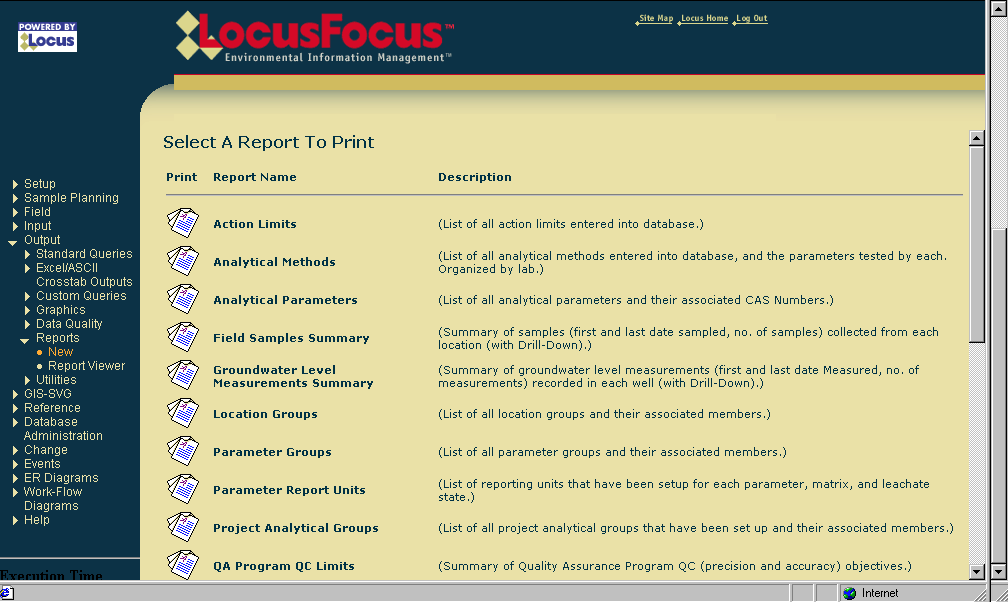
One of the earliest versions of EIM
Oh, how so much has changed in the intervening years! The RFPs that Locus receives these days explicitly call out for a web-based system or, much less often, express no preference for a web-based or client-server system. We believe this change in attitudes toward SaaS applications has many root causes. Individuals now routinely do their banking over the web. They store their files in Dropbox and their photos on sites like Google Photos or Apple and Amazon Clouds. They freely allow vendors to store their credit card information in the cloud to avoid entering this information anew every time they visit a site. No one who keeps track of developments in the IT world can be oblivious to the explosive growth of Amazon Web Services (AWS), Salesforce, and Microsoft’s Azure. We believe most people now have more faith in the storage and backup of their files on the web than if they were to assume these tasks independently.
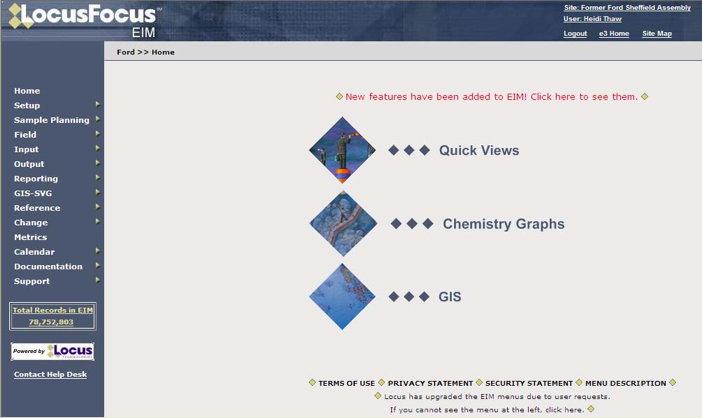
An early update to EIM software
Changes have also occurred in the attitudes of IT departments. The adoption of SaaS applications removes the need to perform system updates or the installation of new versions on local computers. Instead, for systems like EIM, updates only need to be completed by the vendor, and these take place at off-hours or at announced times. This saves money and eliminates headaches. A particularly nasty aspect of local, client-server systems is the often experienced nightmare when installing an updated version of one application causes failures in others that are called by this application. None of these problems typically occur with SaaS applications. In the case of EIM, all third-party applications used by it run in the cloud and are well tested by Locus before these updates go live.
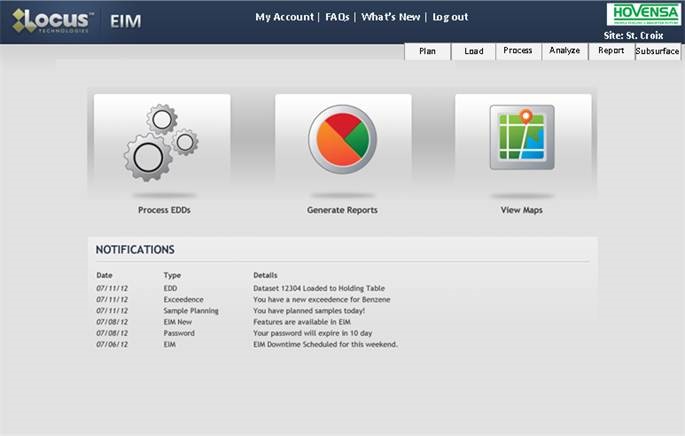
Locus EIM continues to become more streamlined and user friendly over the years.
Yet another factor has driven potential clients in the direction of SaaS applications, namely, search. Initially, Locus was primarily focused on developing software tools for environmental cleanups, monitoring, and mitigation efforts. Such efforts typically involved (1) tracking vast amounts of data to demonstrate progress in the cleanup of dangerous substances at a site and (2) the increased automation of data checking and reporting to regulatory agencies.
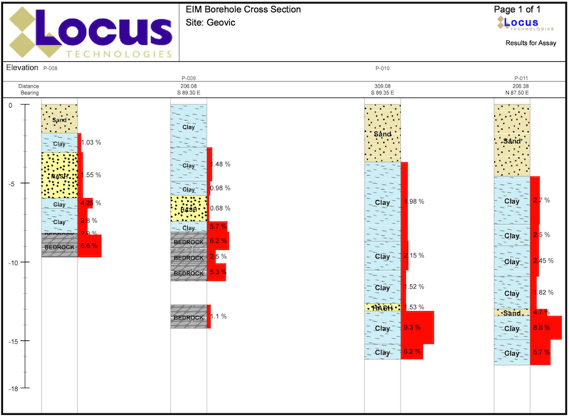
Locus EIM handles all types of environmental data.
Before systems like EIM were introduced, most data tracking relied on inefficient spreadsheets and other manual processes. Once a mitigation project was completed, the data collected by the investigative and remediation firms remained scattered and stored in their files, spreadsheets, or local databases. In essence, the data was buried away and was not used or available to assess the impacts of future mitigation efforts and activities or to reduce ongoing operational costs. Potential opportunities to avoid additional sampling and collection of similar data were likely hidden amongst these early data “storehouses,” yet few were aware of this. The result was that no data mining was taking place or possible.
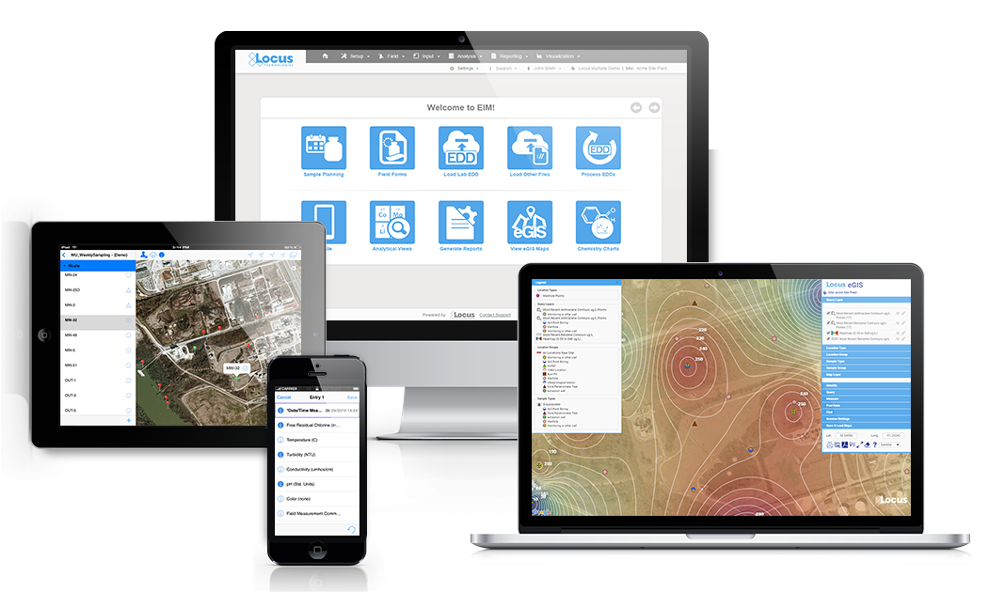
Locus EIM in 2022
The early development of EIM took place while searches on Google were relatively infrequent (see years 1999-2003 below). Currently, Google processes 3.5 billion searches a day and 1.2 trillion searches per year. Before web-based searches became possible, companies that hired consulting firms to manage their environmental data had to submit a request such as “Tell me the historical concentrations of Benzene from 1990 to the most recent sampling date in Wells MW-1 through MW-10.” An employee at the firm would then have to locate and review a report or spreadsheet or perform a search for the requested data if the firm had its database. The results would then be transmitted to the company in some manner. Such a request need not necessarily come from the company but perhaps from another consulting firm with unique expertise. These search and retrieval activities translated into prohibitive costs and delays for the company that owned the site.

Google Searches by Year
Over the last few decades, everyone has become dependent on and addicted to web searching. Site managers expect to be able to perform their searches, but honestly, these are less frequent than we would have expected. What has changed are managers’ expectations. They hope to get responses to requests like those we have imagined above in a matter of minutes or hours, not days. They may not even expect a bill for such work. The bottom line is that the power of search on the web predisposes many companies to prefer to store their data in the cloud rather than on a spreadsheet or in their consultant’s local, inaccessible system.
The world has changed since EIM was first deployed, and as such, many more applications are now on the path, that Locus embarked on some 20 years ago. Today, Locus is the world leader in managing on-demand environmental information. Few potential customers question the merits of Locus’s approach and its built systems. In short, the software world has caught up with Locus. EIM and LP have revolutionized how environmental data is stored, accessed, managed, and reported. Locus’ SaaS applications have long been ahead of the curve in helping private, and public organizations manage their environmental data and turn their environmental data management into a competitive advantage in their operating models.
We refer to the competitive advantages of improved data quality and flow and lower operating costs. EIM’s Electronic Data Deliverable (EDD) module allows for the upload of thousands of laboratory results in a few minutes. Over 60 automated checks are performed on each reported result. Comprehensive studies conducted by two of our larger clients show savings in the millions gained from the adoption of EIM’s electronic data verification and validation modules and the ability of labs to load their EDDs directly into a staging area in the system. The use of such tools reduces much of the tedium of manual data checking and, at the same time, results both in the elimination of manually introduced errors and the reduction of throughput times (from sampling to data reporting and analysis). In short, the adoption of our systems has become a win-win for companies and their data managers alike.
This is the second post highlighting the evolution of Locus Technologies over the past 25 years. The first can be found here. This series continues with Locus at 25 Years: Locus Platform, Multitenant Architecture, the Secret of our Success.
Locus at 25 Years: Who is Locus Technologies?
On 11 April 1997, Neno Duplan and a few colleagues gathered in an attorney’s office at One Front Street downtown San Francisco to begin the Locus journey. Over the next 25 years, these founders and many who later joined them would build a company based on three breakthrough goals: in place of client-server and silo systems, offer organizations cloud-based software and applications to manage their environmental compliance; create a subscription business model, and build an integrated model for emissions and environmental information management. Through these ideas, Locus would come to revolutionize the EHS compliance and sustainability industries.

Figure 1: One Front Street, San Francisco Ca where Locus was founded in 1997
After a lunch at the California’s oldest restaurant nearby, Tadich Grill, Locus was off to the great start.
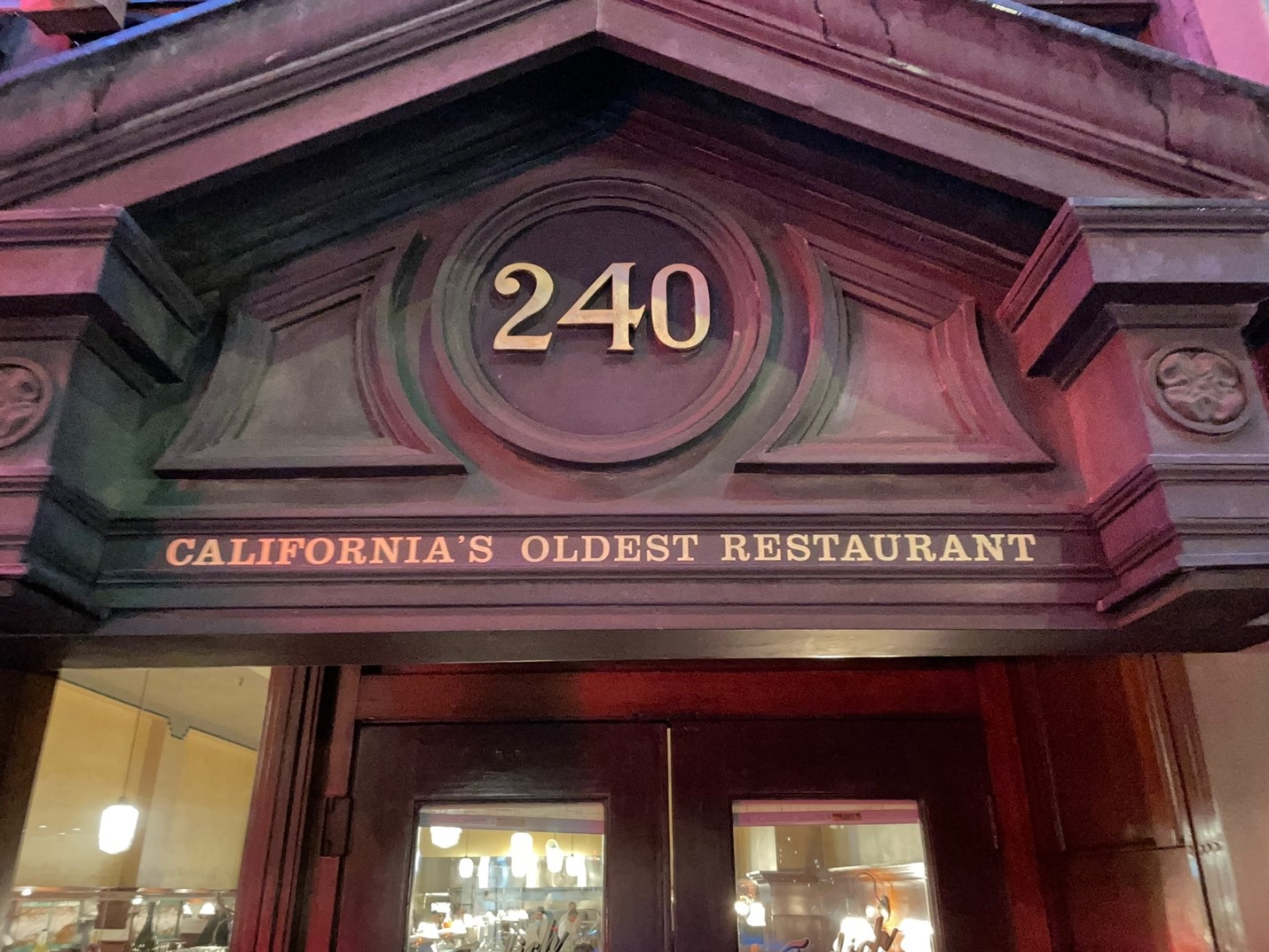
Figure 2: California’s oldest restaurant at California Street

Figure 3: Tadich Grill, California’s oldest restaurant was founded in 1849 by three Croatian immigrants.
Twenty-five years later, Locus continues that revolution, offering integrated EHS and ESG software in the cloud, mobile, IoT, and AI technologies for companies of every size and industry. Locus has changed how companies manage their environmental liability and emissions and, at the same time, improved companies’ means to manage their impacts on the climate and environment. On this 25th birthday, we want to thank our employees and customers who entrusted us with their data. We couldn’t have done any of this without you.
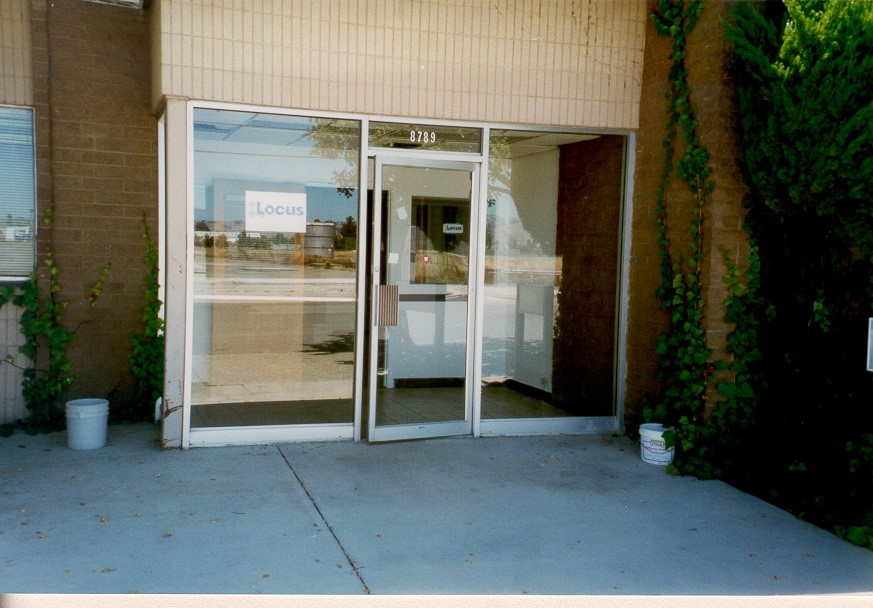
Figure 4: Locus’s first office in Newark, CA
Who is Locus?
We founded Locus with the vision to create a robust online environmental data management and compliance software system to handle the volume and the complexities of environmental data. The company founder and key staff came to Locus with dozens of years of consultant-based environmental data management and compliance experience and with first-hand knowledge of the difficulties and frustrations of homegrown solutions involving spreadsheets and siloed custom software.
Locus is a leading provider of EHS compliance and ESG software and technology-enabled solutions that address a broad range of risk categories across diversified end-markets.
Locus is the only provider of scale with an extensive offering unifying EHS, ESG, and Water solutions and is rapidly expanding $7bn+ addressable market opportunity with significant white space and supported by strong industry tailwinds.
Locus sits at the center of a powerful network, connecting EHS and ESG with technology needs to scale sustainable supply chains
Debuting in 1999, Locus Environmental Information Management (EIM) was the first exclusively online Software as a Service (SaaS) environmental data management system. Since then, it has been in continuous operation and has been continuously upgraded, improved, and enhanced based on technology changes and customer requests. Locus EIM was the first time a large enterprise could purchase a commercially supported system to streamline and manage the entire environmental data management process without needing to buy any hardware or install any software on-premises.
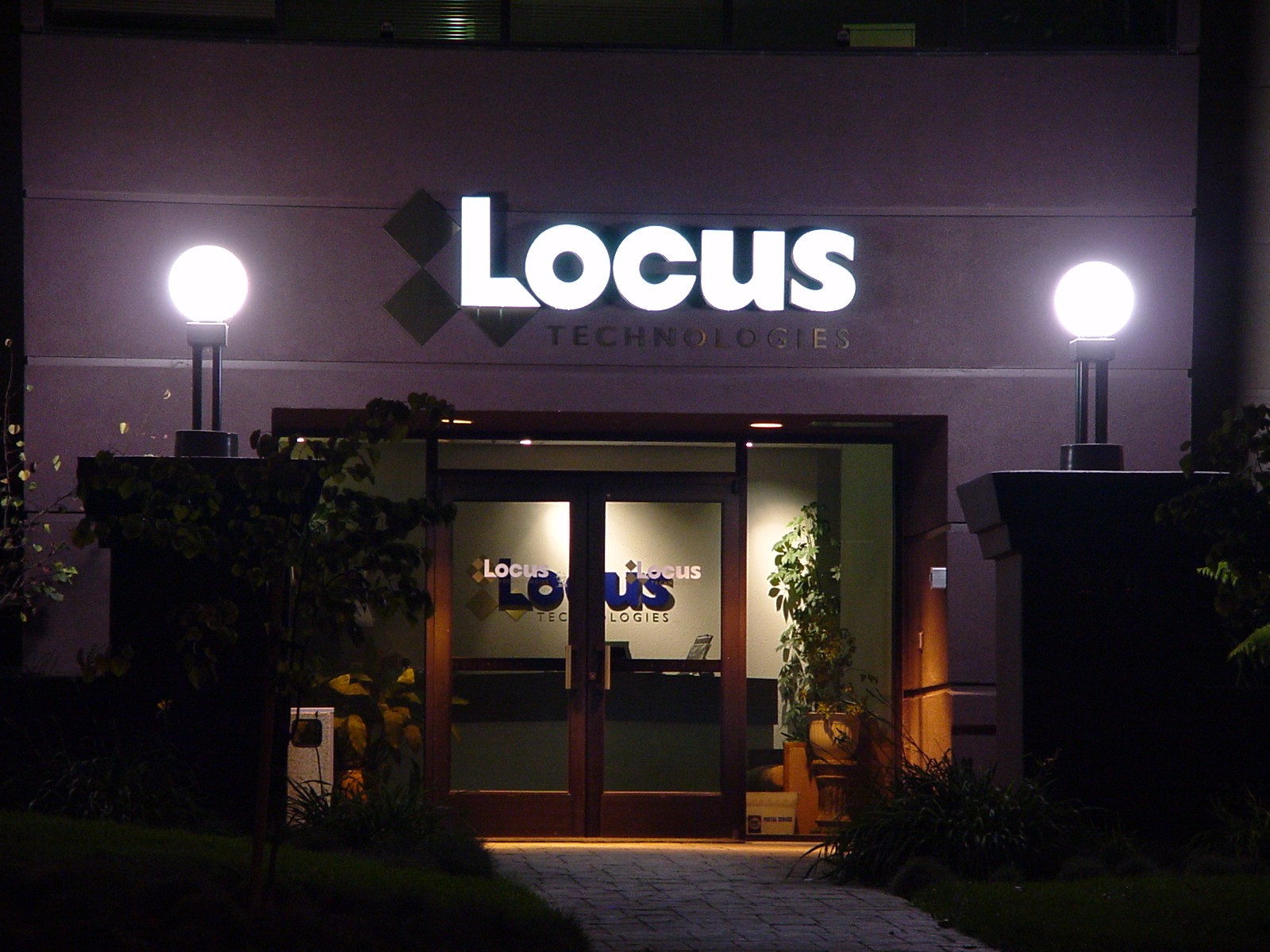
Figure 5: Locus Silicon Valley Headquarters, Mountain View, CA
Following the early success of EIM, in 2000, Locus created the first EHS compliance portal, later named Locus Platform (LP), to house different apps and less structured data such as documents, site information, and obligation and compliance information. This platform evolved over the years into a robust full-blown EHS compliance management tool with many applications. Locus completely rebuilt LP in 2013 using the latest web technologies to provide the EHS industry with the first multitenant solution for EHS compliance management. In its current form, LP offers an intuitive interface with the immense flexibility to incorporate features such as drag-and-drop forms creation, visual business-process modeling, Excel import/export integration, and rich and configurable user dashboards and reporting interface. Locus created every feature with the end-user to promote quick and easy data capture and task management.
The central focus of EIM is the environmental sample and what it tells us about environmental conditions at a site. It is a vertical application designed to store location, sampling, and analytical information. We often refer to EIM as an inch wide and a mile deep. Companies use EIM to store, evaluate, and report contaminants found in the groundwater, surface water, soil, sediments, air, and biota at a site or facility. It is typically the tool of choice for an organization monitoring emissions or study of a potentially contaminated area. In recent years, a version of it has been modified to serve the needs of water utilities for water quality management.
Most data in EIM originates from analytical laboratories, field readings, instrument readings, and consumption meters. Many such data points are transmitted to EIM via IoT technologies. EIM users generally understand sampling protocols, analytical chemistry, water quality, air emissions, sample management, geology, and other technical fields.
In contrast, LP is an expert solution that houses many compliance and task management applications. Its users generally are in oversight or supervisory positions responsible for compliance and task management. LP consumes verified data from EIM to build and report compliance apps. Its tools and flexibility support a full-featured and unified set of Environmental Health & Safety, and sustainability solutions in a single platform.
Today, Locus is an environmental software and service company with headquarters located in Silicon Valley. Our vision of a cloud-based system for accessing and managing environmental data and EHS compliance has now been widely adopted by many companies and industrial sectors and is a technology known to all as Software as a Service (SaaS).
Locus is mainly responsible for creating an emerging technology sector in its niche-storing and managing environmental and sustainability industry data using Cloud Computing. Via its SaaS, Locus is now a leading EHS and ESG SaaS provider and outpaces its competitors in environmental data tracking and compliance management applications.
Locus didn’t start in the clouds, but back in 1997, it had a pretty good view of the road it wanted to head down. Locus evolved from Neno Duplan’s work as a research associate at Carnegie Mellon in the 1980s, where he developed the prototype system for environmental information management and display using microcomputers. This early work led to the development of numerous database management systems at some of the nation’s largest environmental sites and ultimately to the formation of Locus Technologies in 1997.
In Locus’ second anniversary letter on 15 April 1999, Neno Duplan wrote:
In the short term, we will drive revenue growth through geographical expansion and by fully supporting the development of our Internet-based products and services. We plan to use our Internet-based and information management technologies to revolutionize the industry. These new products will keep us competitive and open a world of opportunities for Locus and our clients.
Locus’ vision of providing companies with the tools they need for better global environmental stewardship has not changed since its inception. We focus on empowering organizations to manage and mitigate the environmental impact of their activities. That vision has come to fruition as Locus’ software services are now used by some of the world’s largest companies and government organizations.
This series continues with: Locus at 25 Years with: Locus EIM and the Triumph of the SaaS Model.
Locus Technologies
299 Fairchild Drive
Mountain View, CA 94043
P: +1 (650) 960-1640
F: +1 (415) 360-5889
Locus Technologies provides cloud-based environmental software and mobile solutions for EHS, sustainability management, GHG reporting, water quality management, risk management, and analytical, geologic, and ecologic environmental data management.
